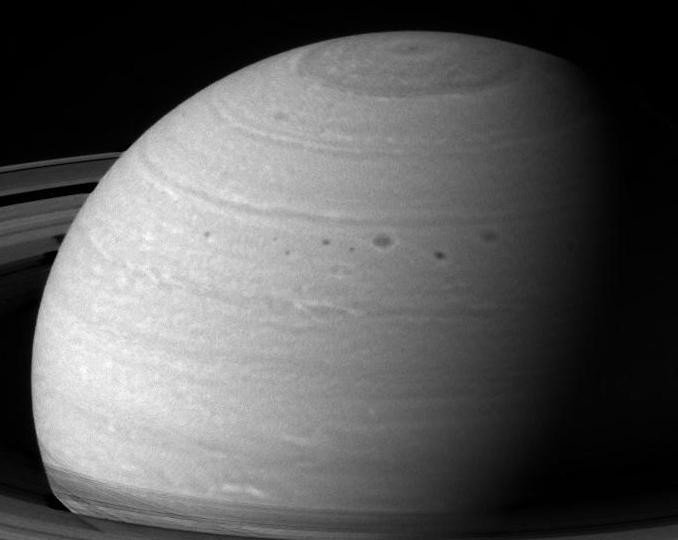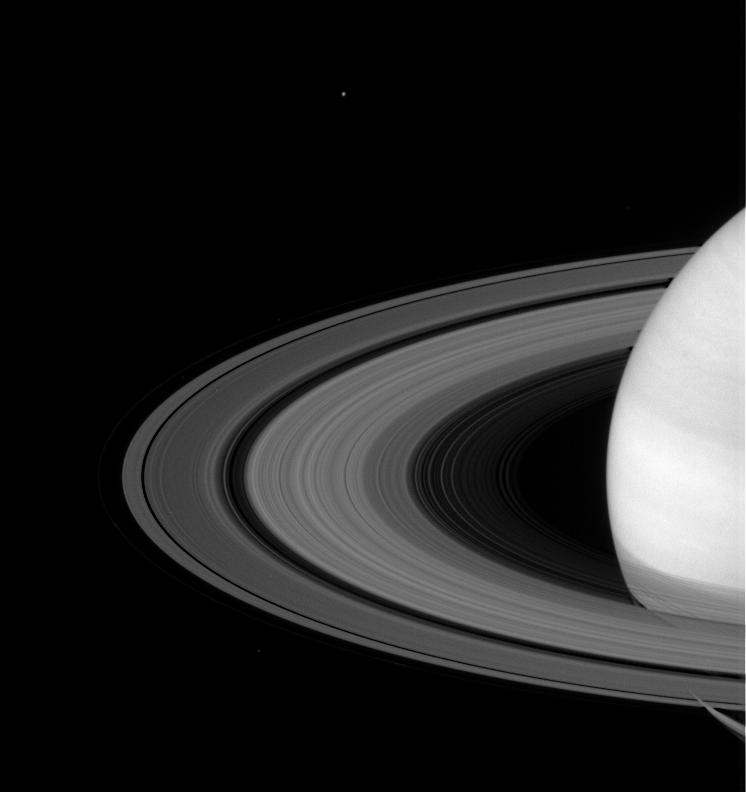|
The Cassini-Huygens mission
|
South up  Original image tif 477kB Original image tif 477kB

Original Caption Released with Image:
The high clouds of Saturn's bright equatorial band appear to stretch like cotton candy in this image taken by the Cassini narrow angle camera on May 11, 2004. The icy moon Enceladus (499 kilometers, or 310 miles across) is faintly visible below and to the right of the South Pole. The image was taken from a distance of 26.3 million kilometers (16.3 million miles) from Saturn through a filter centered at 727 nanometers. The image scale is 156 kilometers (97 miles) per pixel. No contrast enhancement has been performed on this image.
The Cassini-Huygens mission is a cooperative project of NASA, the European Space Agency and the Italian Space Agency. The Jet Propulsion Laboratory, a division of the California Institute of Technology in Pasadena, manages the Cassini-Huygens mission for NASA's Office of Space Science, Washington, D.C. The Cassini orbiter and its two onboard cameras, were designed, developed and assembled at JPL. The imaging team is based at the Space Science Institute, Boulder, Colo.
For more information, about the Cassini-Huygens mission visit, http://saturn.jpl.nasa.gov and the Cassini imaging team home page, http://ciclops.org.
Image Credit:
South up  Original image tif 477kB Original image tif 477kB

Original Caption Released with Image:
This image shows several dark storms confined to a region below 30 degrees south latitude in Saturn's atmosphere. This turbulent region has produced quite a few storms during Cassini's approach to Saturn, including some that have merged. A number of other interesting smaller-scale atmospheric features are also becoming visible.
The image was taken with the Cassini spacecraft narrow angle camera on May 11, 2004, from a distance of 26.4 million kilometers (16.4 million miles) from Saturn through a filter centered at 750 nanometers. The image scale is 157 kilometers (98 miles) per pixel. Contrast in the image was enhanced to aid visibility.
The Cassini-Huygens mission is a cooperative project of NASA, the European Space Agency and the Italian Space Agency. The Jet Propulsion Laboratory, a division of the California Institute of Technology in Pasadena, manages the Cassini-Huygens mission for NASA's Office of Space Science, Washington, D.C. The Cassini orbiter and its two onboard cameras, were designed, developed and assembled at JPL. The imaging team is based at the Space Science Institute, Boulder, Colo.
For more information, about the Cassini-Huygens mission visit, http://saturn.jpl.nasa.gov and the Cassini imaging team home page, http://ciclops.org.
South up  Original image tif 270kB Original image tif 270kB

Original Caption Released with Image:
Saturn's magnificent rings show some of their intricate structure in this image taken on May 11, 2004, by the Cassini spacecraft's narrow angle camera. Although they appear to be solid structures, the rings are composed of billions of individual particles, each one orbiting the planet on its own path.
Satellites visible in this image: Janus (181 kilometers, or 113 miles across) above the rings, and icy Enceladus (499 kilometers, or 310 miles across) below the rings. The F ring shepherd moons Prometheus and Pandora can be seen along Saturn's outermost F ring if the image is further contrast enhanced. The image was taken in visible light from a distance of 26.3 million kilometers (16.4 million miles) from Saturn. The image scale is 158 kilometers (98 miles) per pixel. Contrast in the image was enhanced to aid visibility.
The Cassini-Huygens mission is a cooperative project of NASA, the European Space Agency and the Italian Space Agency. The Jet Propulsion Laboratory, a division of the California Institute of Technology in Pasadena, manages the Cassini-Huygens mission for NASA's Office of Space Science, Washington, D.C. The Cassini orbiter and its two onboard cameras, were designed, developed and assembled at JPL. The imaging team is based at the Space Science Institute, Boulder, Colo.
[NASA/JPL/Space Science Institute]
 ALPO-Japan Latest ALPO-Japan Latest

 Saturn Section Saturn Section
|


 Original image tif 477kB
Original image tif 477kB 
 Original image tif 477kB
Original image tif 477kB 
 Original image tif 270kB
Original image tif 270kB 
 ALPO-Japan Latest
ALPO-Japan Latest

 Saturn Section
Saturn Section